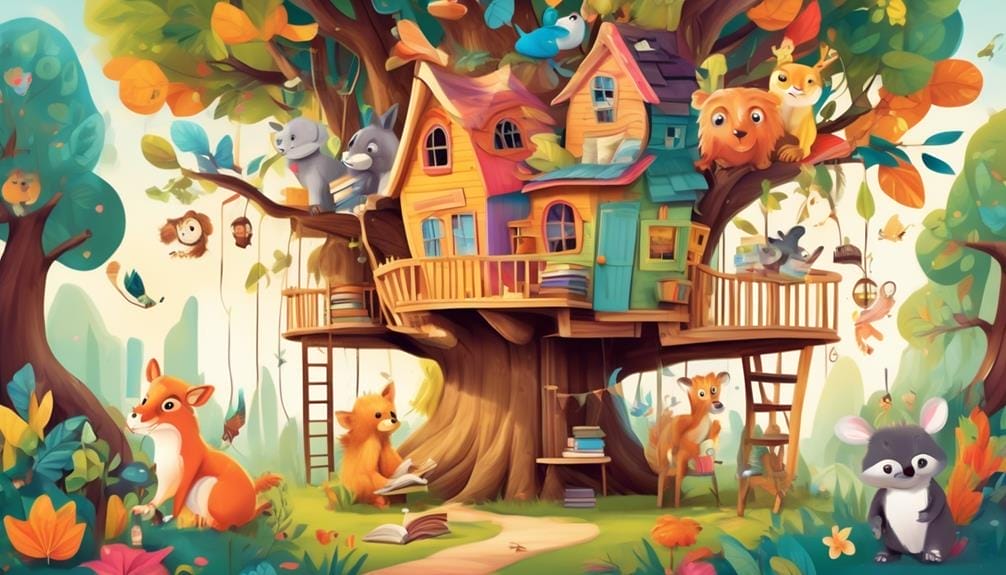Imagine stumbling upon a hidden treasure chest that's filled with precious gems, waiting to be discovered by young minds. Writing for Young Readers is your key to unlocking this treasure trove, where you'll learn the art of captivating storytelling for children and young adults.
In this course, you'll delve into the secrets of establishing effective writing habits, infusing your personal experiences into your work, exploring popular genres, and understanding the minds of your target audience.
But that's just the beginning. As you embark on this journey, you'll be guided by experienced instructors, Maria Gill and Alex Alexandrou, who will share their expertise to help you craft stories that leave a lasting impact.
So, are you ready to embark on an adventure that will ignite the imagination of young readers?
Key Takeaways
- Childhood memories and experiences can provide relatable and authentic material for stories.
- Creating engaging and captivating characters is essential to connect with young readers.
- Drawing inspiration from personal experiences, culture, and myths can enhance character development.
- Age-appropriate themes and topics should be explored to help children navigate and understand the world.
Understanding the Young Reader's Mind

To truly connect with young readers, you must delve into the depths of your childhood memories and bring forth stories that ignite their imagination and resonate with their hearts. Writing for young readers is a delicate art that requires understanding their unique perspective and mindset. By tapping into your own childhood experiences, you can create stories that are relatable and authentic, capturing the essence of what it means to be a child.
Young readers crave stories that reflect their own lives and emotions. By addressing complex topics and exploring the dynamics between adults and children, you can create powerful and engaging narratives that captivate their attention. Judy Blume, a renowned author with over 85 million copies sold, understands the importance of connecting with young readers. In her MasterClass on writing for young readers, she shares her insights and techniques for crafting stories that resonate with children.
Understanding the young reader's mind involves drawing on personal childhood themes. Remembering the curiosity, innocence, and sense of wonder that defined your own childhood allows you to create characters and situations that young readers can relate to. By infusing your stories with these authentic experiences, you can transport young readers to worlds that feel familiar yet full of adventure.
Crafting Engaging Characters
Are you ready to embark on a journey of character development? Crafting engaging characters is like creating a puzzle, piecing together different traits, personalities, and quirks to make them come alive on the page.
By drawing on your own experiences and understanding the young reader's mind, you can create characters that captivate and resonate with your audience, taking them on unforgettable adventures and leaving a lasting impression.
Character Development Techniques
Crafting engaging characters for young readers involves tapping into your personal experiences and culture, allowing you to enrich your writing and establish effective writing habits. To develop characters that resonate with young audiences, you can draw inspiration from myths, legends, and different viewpoints. By incorporating these elements, you add depth and intrigue to your characters, making them more relatable and appealing. Additionally, reflecting on childhood experiences, memories, and observations of children can help you create characters that young readers can connect with on a deeper level.
Addressing complex topics and exploring adult-child dynamics in your writing can lead to powerful storytelling and character development. This allows you to create multi-dimensional characters that young readers can empathize with and learn from. By employing these character development techniques, you can invent vivid characters, write realistic dialogue, and develop vibrant stories that captivate young minds. Judy Blume's MasterClass on writing for younger readers provides valuable lessons on these techniques, helping you refine your skills and create engaging characters that leave a lasting impact.
| Character Development Techniques |
|---|
| Draw on personal experiences and culture |
| Incorporate myths, legends, and different viewpoints |
| Reflect on childhood experiences and observations of children |
| Address complex topics and explore adult-child dynamics |
| Learn from Judy Blume's MasterClass on writing for younger readers |
Captivating Young Readers
Embark on a thrilling adventure through the pages of captivating stories as you meet vibrant characters who'll whisk you away to imaginative worlds.
In the world of writing for young readers, crafting engaging characters is essential to captivate their attention and foster a love for reading. Here are three sub-lists to draw you into the enchanting realm of captivating young readers:
- Relatable protagonists: Step into the shoes of characters who face relatable challenges, making you feel connected to their journey.
- Memorable personalities: Encounter characters with unique traits and quirks that leave a lasting impression, inviting you to explore their fascinating lives.
- Dynamic relationships: Dive into the intricacies of friendships, family dynamics, and unexpected alliances that add depth and complexity to the story, keeping you engaged till the very end.
Prepare to be enthralled as you encounter these captivating characters, who'll inspire your imagination and ignite your love for storytelling.
Age-Appropriate Themes and Topics

Are you ready to explore the world of age-appropriate themes and topics in writing for young readers?
When crafting stories for kids, it's crucial to consider what content is suitable for their age group. By creating engaging and relatable stories, you can capture their attention and make a lasting impact.
It's also important to weave positive moral messages into your storytelling, helping to shape young minds and instill valuable lessons.
Suitable Content for Kids
Creating content that's suitable for kids involves selecting age-appropriate themes and topics that capture their imagination and foster their emotional development.
To ensure suitable content for kids, consider the following:
- Tapping into your own childhood experiences can help you relate to younger readers and create stories that resonate with them.
- Using childhood themes in writing, such as friendship, family, and adventure, can create emotional connections and make stories relatable to young readers.
- Addressing complex topics in children's literature, like adult-child dynamics and childhood challenges, can help children navigate and understand the world around them.
Engaging and Relatable Stories
To captivate young readers, infuse your stories with age-appropriate themes and topics that ignite their imagination and foster emotional development. Engaging and relatable stories are essential for capturing the attention of young readers.
Drawing on myths, legends, and different viewpoints adds depth to your writing and makes it more interesting for your audience. Explore genres and forms that are popular with young readers to understand their preferences and make your work appealing to them.
Tap into your own childhood experiences and themes to enhance your storytelling and create a connection with younger readers. Addressing complex topics and exploring the dynamics between adults and children can create powerful and relatable stories.
Take inspiration from renowned author Judy Blume, who offers a MasterClass on writing for younger readers, focusing on inventing vivid characters, writing realistic dialogue, and developing vibrant stories.
Positive Moral Messages
Children's literature has the extraordinary ability to instill positive moral messages and age-appropriate themes that shape young minds and leave a lasting, meaningful impression.
When you read books with positive moral messages, you learn important life lessons that can guide you through challenging situations. These stories teach you about kindness, empathy, and the importance of making good choices. They inspire you to be brave, to stand up for what's right, and to treat others with respect and fairness.
By exploring age-appropriate themes, such as friendship, family, and self-discovery, children's literature helps you navigate your own experiences and emotions. It allows you to see yourself reflected in the characters and stories, fostering a sense of belonging and understanding.
Developing an Engaging Plot

Develop a plot that captivates young readers by weaving together exciting adventures and relatable emotions. When writing for young readers, it's important to create a storyline that grabs their attention from the very beginning and keeps them turning the pages. To develop an engaging plot, consider incorporating the following elements:
- Conflict: Introduce a problem or challenge that the main character must overcome. This could be a physical obstacle, an emotional struggle, or a combination of both. By creating conflict, you create tension and keep young readers invested in the story.
- Action: Include exciting and suspenseful events that propel the story forward. Think about incorporating adventures, mysteries, or unexpected twists and turns. Young readers love to be swept away on thrilling journeys.
- Emotion: Infuse the plot with relatable emotions that young readers can connect with. Whether it's friendship, love, fear, or sadness, emotions add depth and help young readers form a personal connection to the characters and story.
Writing Authentic Dialogue
As the adventures unfold and the emotions run high, it's crucial to capture the essence of authentic dialogue in your writing for young readers. Writing authentic dialogue allows your characters to come to life and creates a connection between them and your audience.
Here are some tips to help you master the art of writing authentic dialogue:
- Reflect real-life conversations: Authentic dialogue should mirror the way people actually speak. Use contractions, slang, and colloquialisms to make your characters sound relatable and natural.
- Reveal personalities and emotions: Dialogue is a powerful tool for showing who your characters are and how they feel. Let their words reflect their unique personalities and emotions, whether it's through their tone, word choice, or speech patterns.
- Avoid exposition: Dialogue shouldn't be used as a means of dumping information on your readers. Instead, let your characters' words reveal information subtly, through their interactions and the context of the story.
Creating Memorable Settings

Step into a world of wonder and imagination as you explore the art of creating memorable settings in your writing for young readers. The setting of a story plays a crucial role in captivating your audience and immersing them in your narrative. By drawing on personal childhood experiences and themes, you can make your setting authentic and relatable to young readers.
To help you in your quest to create memorable settings, let's take a look at some key ideas:
| Utilize Childhood Experiences | Tap into Childhood Themes |
|---|---|
| Childhood experiences can enrich your writing by adding depth and personal connection to the setting. | Drawing on personal childhood themes can make the setting of a story authentic and relatable to young readers. |
| Tapping into childhood experiences and themes can enhance the vividness and emotional resonance of the setting. | Utilizing childhood themes can make the setting of a story nostalgic and familiar, creating emotional connections with the readers. |
| Childhood settings and experiences provide valuable insights and inspiration for creating memorable settings in stories for young readers. |
Incorporating Fun and Interactive Elements
Get ready to embark on an exciting journey filled with laughter, learning, and adventure as you discover the magic of incorporating fun and interactive elements into your writing for young readers. By infusing your stories with these elements, you can captivate and engage your young audience in a way that will leave a lasting impression.
Here are some ways to make your writing more fun and interactive:
- Multimedia Marvels: Take advantage of technology by incorporating videos, interactive quizzes, and games into your writing. This not only makes the learning experience more enjoyable, but it also helps young readers retain information better.
- Relatable Characters and Stories: Introduce characters, stories, and scenarios that young readers can easily relate to. By creating relatable situations, you invite young readers to become active participants in the story, sparking their imagination and creativity.
- Hands-On Activities and Creative Writing: Encourage young readers to actively participate in the learning process by including hands-on activities and creative writing exercises. This not only makes the experience more enjoyable, but it also allows them to apply what they've learned in a fun and practical way.
Incorporating these fun and interactive elements into your writing won't only make it more enjoyable for young readers, but it will also enhance their engagement, learning, and overall reading experience. So, get ready to embark on this magical journey and watch as your young readers become immersed in the wonders of your storytelling.
Editing and Polishing Your Manuscript

Now that you've woven fun and interactive elements into your writing, it's time to polish and refine your manuscript to captivate young readers even further. Editing and polishing your manuscript involves refining your writing to make it more engaging and appealing to the target audience. Pay attention to the structure, plot, character development, and dialogue to ensure a well-crafted and coherent story.
To create a captivating manuscript, draw upon your personal experiences, culture, and childhood memories. Adding depth and authenticity to your writing will resonate with young readers and make your story more relatable. Address complex topics and explore childhood themes to create stories that are both entertaining and thought-provoking.
After you've made revisions based on your own insights, seek feedback from peers, instructors, or industry professionals. Their fresh perspective can help you identify areas for improvement and bring your manuscript to its full potential. Take their suggestions into consideration and revise accordingly.
As you edit and polish your manuscript, remember to strive for clarity, conciseness, and precision. Make sure your writing flows smoothly and avoids unnecessary fluff. By carefully refining your manuscript, you can ensure that it captivates young readers and leaves a lasting impression.
Frequently Asked Questions
How Do You Write for Younger Readers?
You write for younger readers by using interactive storytelling techniques. Engage their imaginations with age-appropriate content and create characters they can relate to. Make the story come alive through vivid descriptions and realistic dialogue.
How Do You Write a Book for Young Readers?
To write a book for young readers, let your creativity soar like a bird in the sky. Engage their minds with imaginative storytelling that sparks their curiosity and captures their hearts.
How to Write a Book for 5 8 Year Olds?
To write a book for 5-8 year olds, focus on character development. Create relatable and engaging characters by drawing on childhood experiences and themes. Use vivid language and imagination to capture their attention and make the story come alive.
How Much Do Children's Book Authors Make?
You can potentially make a good income as a children's book author. The publishing industry offers various opportunities to earn money through book sales, royalties, and licensing deals.
Conclusion
Congratulations on completing the Writing for Young Readers course!
You've delved into the minds of young readers, crafted captivating characters, explored age-appropriate themes, and developed engaging plots.
With your newly acquired skills, you're ready to create authentic dialogue, unforgettable settings, and incorporate interactive elements into your writing.
Remember, the process of editing and polishing your manuscript is crucial for creating a masterpiece.
Keep honing your skills and let your imagination soar as you embark on your writing journey.
Happy writing!


